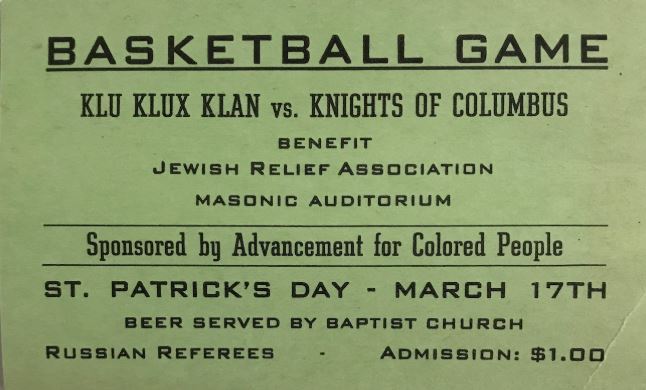KKK & The Party: A Series on the Democratic Party in America Part 3
February 2019

Politifact.com asserts that it is not fair to say that the Democratic Party founded the Ku Klux Klan, a white supremacist group found primarily in the Southern United States. What they could confer is that many early Democrats used the Klan as their strong arm. Of course, as with any underground organization, there is no transparency. Even the hooded marchers themselves disguise their racist identities in order to infiltrate mainline organizations, even politics. In 1868, during future Democratic President Woodrow Wilson’s impressionable youth, the Klan served as a major part of the Democratic party, speaking at the National Convention and holding elected office. Klan members taunted their white might slogans at every turn, using tactics to legally bind blacks across Dixie. Klansmen even marched on Washington, routinely burning crosses, terrorizing citizens, and dividing the nation. The major theme of the loudest voices in America yelled, “This is a White Man’s Country, Let White Men Rule.”
In 1872, during the next nationwide election cycle, the theme was “New Departure,” a departure from the Republican reforms of Reconstruction and rebuilding the south after the Civil War. When Congress attempted to transform the war torn south, Democrat-led southern states reconciled themselves to political rhetoric since military manpower had lost out. In short, a different kind of fight to keep African-Americans diminished was put into motion. The Klan played an active role in keeping freed blacks from voting, achieving economic advancement, or exercising any rights that our Constitution provided. In those days the Republican platform was called liberal by Dixiecrats who saw the idea of making segregation illegal a progressive notion. Liberalism became synonymous with the Republicans efforts to end segregation in the south. The term liberal during this time in America’s history bears little resemblance to the current definition, because the initial meaning was based on Constitutionality that was systemically deprived from black citizens by deep state racism in our nation.
A splinter group, receiving less that one percent of the vote, called themselves the Straight Out Democrats, a conservative base that supported a Charles O’Connor/John Quincy Adams II ticket in the election cycle shortly after the Civil War. They held a national convention in Louisville, Kentucky, on the basis that any voter turn out would not result in electoral college votes because the Democratic National Committee did not recognize the Straight Out Democrats as an official political party. In other words, the few conservative Democrats that broke away from the racist policies of the party were politically ostracized for their conservative stance, and barely recognized by the people. The Democratic Party during the Klan’s infiltration into politics represents a truly liberal platform more representative of modern definitions.
The Republican party also experienced a split in 1872. The Liberal Republican Party nominee, Horace Greeley, a candidate who failed to secure the bid for the Republican nomination, became the Liberal Republican Party nominee for the presidency and was eventually support by the Democratic Party within months of the election. While the Liberal Republican Party platform valued some of the same principles of their more conservative counterpart, such as matters concerning the equality of all men regardless of color, persuasion (whose broadest terms include matters of sexuality), religion, nativity or race, there was a debate about how maters of reconstruction would be carried out. In just seven years after the Civil War, Democratic support of Horace Greeley to divide the chances of Republicans in the 1872 election ended poorly for the party who lost to Ulysses S. Grant’s Republicans. Their efforts to “remove the vestiges of Confederate nationalism, racism, and slavery” were seen as the best interest of the Union by the people who vastly voted in the war hero.
Greeley, who popularized the slogan, “Go West, young man, and grow up with the country,” eventually served in Congress, representing New York; and continued to promote his ideas of feminism and socialism. Re-constructionist ideals of the first two years of Grant’s administration caused southern Democrats to rise up at the polls. In 1874, the policies of Grant’s administration were called Pro-Black. Democrats exploited the inadequate implementation of reconstruction policies as a failure of the administration and (Democrats) took control of the House of Representatives. Democrats also had a majority in the Senate as a result of the criticisms of Grant’s White House. This set in order the introduction of Jim Crow laws.
Democratic led House and Senate called for the removal of federal troops from southern states, leaving newly freed blacks to fend for themselves in post-Civil War America. State and local laws in Democratic-led state legislatures after Reconstruction brought about radical change in the former Confederate States of America. Jim Crow, modeled partially after a caricature of a man in black face, kept Americans oppressed, economically and socially, in a time when the country was trying to heal from the battles that killed a generation of soldiers. Jim Crow laws led to “separate but equal” racial segregation doctrines. The laws institutionalized economic, social, and educational disadvantages for non-white communities including poll taxes which kept blacks from exercising their rights to vote.
These decades of disenfranchisement of black communities was highlighted by racist leadership in the south. More famous, perhaps, than any other was Woodrow Wilson. His pattern of appointing Southern Democrats to his cabinet ensured the segregationist patterns would become more and more common place. Wilson believed segregation was better for both African-Americans and European-Americans alike. The Great Reunion of 1913 was led by the spirit of white supremacy and the solid oppression of blacks in the south was embedded even in the face of early attempts to quell Jim Crow segregation under Charles Sumner’s Republican leadership.
Republicans criticized Democrats for using “slave power” to influence the federal government even after the abolition of slavery. For example, South Carolina Democratic Senator Andrew Butler was an avid proponent of slavery. His ties to the KKK were further evidenced by his families strong hold on Congress ( a cousin, his brother, and nephew all served in the US Congress). The National Historic Registry application for the Butler Family Cemetery in South Carolina indicated Andrew Butler was a champion for nullification, urging states to choose rights for themselves despite the passing of the Reconstruction amendments which supported the abolition of slavery and other rights concerning the descendants of slaves.
Like many southern states, North Carolina (Congressman Brooks, Governor Manning, and Judge Heyward), Georgia (Governors Cobb, Forsyth, Early, Telfair, Troup, Walton, Milledge, Colquitt, Crawford, and Senator Barrien), Alabama (Governors Watts and Bibb), South Carolina (Senator W. Hampton I, Judge Heyward, and Governor W. Hampton III), and Tennessee (Governor Houston), all had Democratic leaders who were slave owners. William Aiken, Jr., former Governor of South Carolina, for example, was considered one of the nine biggest slave owners in the Union. Freemason and acting Democratic President on March 4, 1849, David Atchinson was a slave owner and Klan supporter. Democratic President Andrew Jackson owned and traded slaves while in office and did not free them upon his death. Democratic President William Henry Harrison owned slaves, led a pro-slavery movement in the western territory, and fathered six children with one of his female slaves. Harrison’s funeral procession was detailed in the memoir Twelve Years a Slave. James Polk, eleventh President of the United States, became the Democratic nominee for president in 1844 partially because of his tolerance of slavery, in contrast to Van Buren. He generally supported slavery as president. His will provided for the freeing of his slaves after the death of his wife, though the Emancipation Proclamation and the Thirteenth Amendment to the United States Constitution ended up freeing them long before her death in 1891, according to research.
Madison, the third President of the United States who was in office before the Democratic-Republicans split into two parties, proposed the three-fifths compromise stating that slave labor was a necessity to the southern economy. His private thoughts notwithstanding, Madison was a weak president on the issue of slavery. John Tyler, tenth President of the United States, a Democrat turned Whig, was a strong support of state’s rights and believed and owned slaves. His goal was to regulate slavery as to tax it and allow it throughout the territory. All of these leaders had strong ties to slavery and the oppression of blacks, many even after the abolition of slavery. President Van Buren, the founder of the original Democratic Party, was a proponent of slavery while in office. However, after his presidency became more conservative regarding the institution and support Abraham Lincoln’s petition to end slavery. Like abortion in today’s political debate, slavery was the deciding factor between Democrats and Republicans in the early years of our nation.
Most wealthy landowning families in the new colonies and afterward owned slaves. However, in the very early years of our nation, the abolitionist movement in the New England states had a great effect of gaining political favor. The country was soon divided on the issue of slavery, Republicans seeking to dissolve the practice, Democrats defending the practice. When the Civil War broke out, there were effectually no slaves in the Northern part of the country.
Looking back from Wilson to Reconstruction is important to demonstrate the lengthy relationship the Ku Klux Klan had with the Democratic Party. Eighteen Presidents, including George Washington, owned slaves. Even Abraham Lincoln’s Vice President, Andrew Johnson, who assumed the presidency after his assassination, owned slaves. This is an odious part of America’s history. However, northern Republicans changed their views on slavery when southern Democrats held firm to the cause of ‘states rights,’ for nearly 100 years after we won our independence from England. According to the History Channel, “Such tendentious revisionism may provide a useful corrective to older enthusiastic assessments, but it fails to capture a larger historical tragedy: Jacksonian Democracy was an authentic democratic movement, dedicated to powerful, at times radical, egalitarian ideals — but mainly for white men.” Slavery, the use of the Ku Klux Klan as a social restraint, political infiltration, especially in the south, and economic and educative inferiority kept the sons and daughters of slaves, and former slaves, imprisoned. Jacksonian Democrats, those in office after 1829, did not want to upset the delicate balance of power among white men. They considered blacks, Hispanics, and Indians to be inferior peoples and favored establishing norms that would benefit poor whites over reconstruction ideas that benefited people of color.
Perhaps no one will ever be able to find the clear link of affiliation between early Democrats and the KKK, but the pattern of “if the shoe fits, wear it” is clear. These slave owners who did nothing to prohibit Klan activity, used their political power to oppress freed blacks and did little to promote the ideas of reconstruction in the south. In short, the only difference between Democrats and the Ku Klux Klan in the days after the Civil War was the costume they wore.
Source
Jacksonian Democracy
An ambiguous, controversial concept, Jacksonian Democracy in the strictest sense refers simply to the ascendancy of…
www.history.com
Jim Crow laws - Wikipedia
needs additional citations for verification .improve this article by adding citations to reliable sources. Unsourced…
en.wikipedia.org
No, the Democratic Party didn’t create the Ku Klux Klan
President Donald Trump has faced criticism for normalizing white nationalists but some conservative bloggers are trying…
www.politifact.com
RacismDemocratsKu Klux KlanOpinionPresident
comments powered by Disqus
